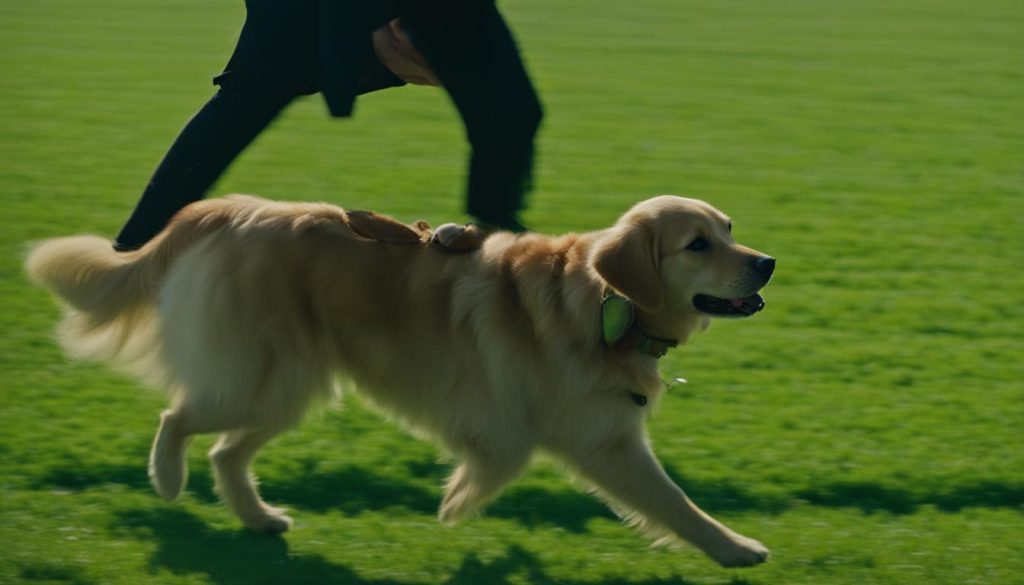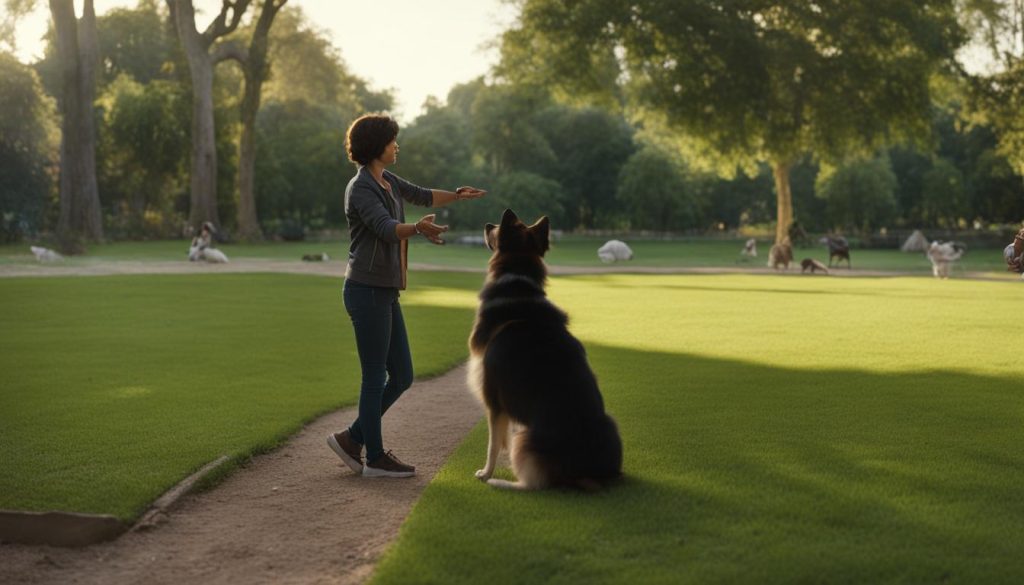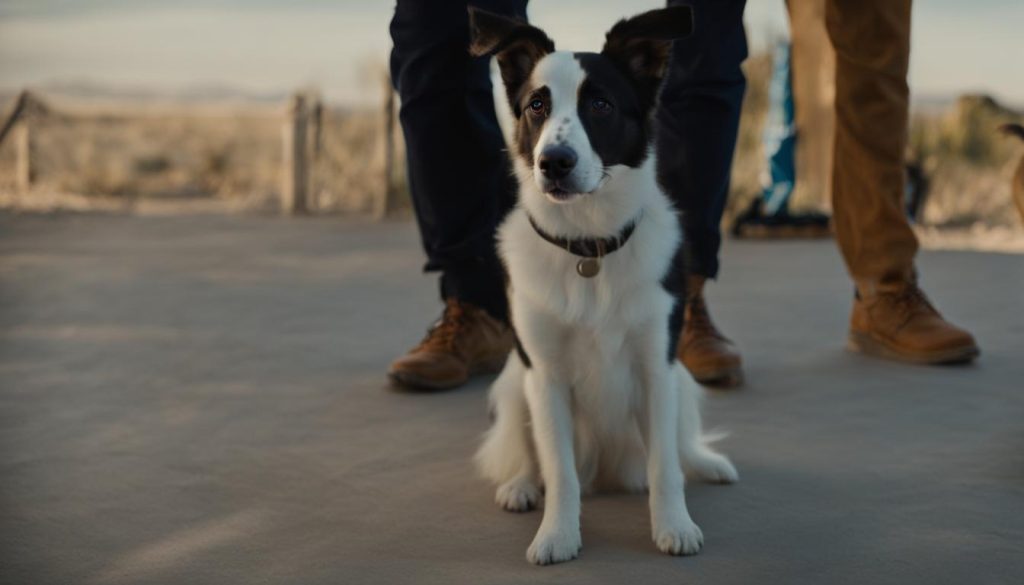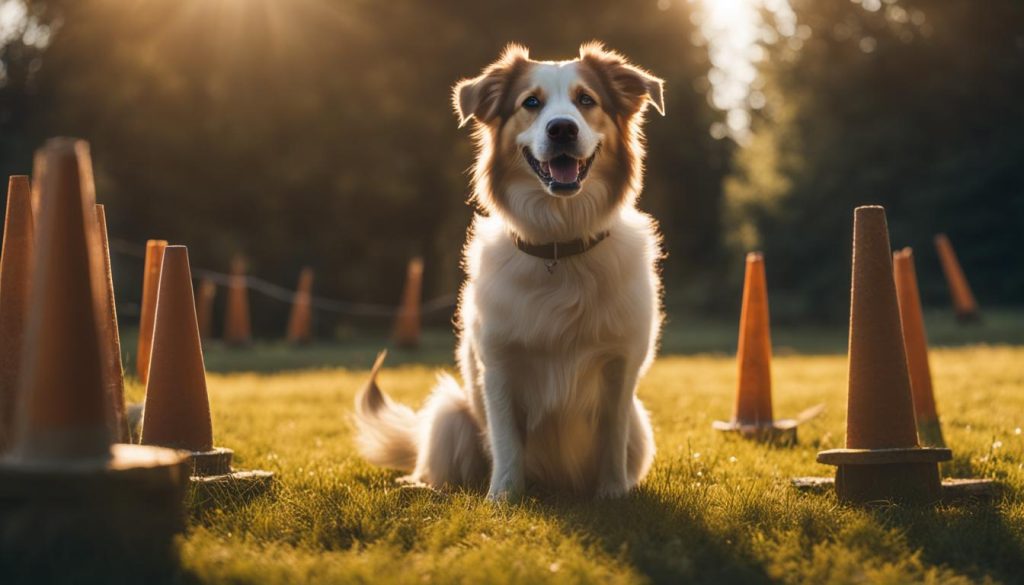Teaching your dog new tricks is an exciting and rewarding experience for both you and your furry friend. In this article, I will guide you through the process of teaching your dog to stand up on command. Whether you need your dog to stand still for grooming, veterinary exams, or dog sports, the stand command is an important skill to have in their repertoire. With the right training techniques and consistent practice, you can successfully teach your dog to stand tall and command attention in various situations.
Key Takeaways:
- Teaching your dog to stand up on command is a valuable skill for various situations.
- Luring your dog into a stand using a treat can be an effective training method.
- Capturing the stand behavior when your dog naturally offers it can also be successful.
- Adding the stay command to the stand can further improve your dog’s obedience.
- Be patient, use positive reinforcement, and gradually increase distance and duration for a successful training outcome.
The Importance of the Stand Command
The stand command is an essential part of dog obedience training that can greatly benefit both you and your furry friend. Teaching your dog to stand on command has numerous practical applications in everyday scenarios. From easily putting on their harness to handling grooming tasks, the stand position makes it easier to perform necessary tasks without any resistance from your dog.
In addition to its practical uses, the stand command is also crucial in dog sports such as conformation shows, Rally, and Obedience. It helps improve your dog’s behavior and obedience, making your interactions with them smoother and more enjoyable. By teaching your dog to stand on command, you will have greater control over their actions and be able to address any behavioral issues more effectively.
Furthermore, the stand command is an excellent way to strengthen the bond between you and your dog. It requires focus and attention from your dog, fostering a deeper connection and enhancing their overall training progress. By consistently practicing the stand command, you are not only teaching your dog a valuable skill but also building trust and communication between you and your furry companion.

The Benefits of Teaching the Stand Command
When you teach your dog the stand command, you are providing them with the tools to navigate various situations with ease. Here are some of the key benefits of teaching your dog to stand:
- Facilitates grooming tasks and veterinary exams.
- Enables easier handling during everyday activities.
- Improves behavior and obedience.
- Enhances focus and attention.
- Strengthens the bond between you and your dog.
- Prepares your dog for participation in dog sports.
By understanding the importance of the stand command and implementing effective training methods, you can help your dog become a well-behaved and obedient companion.
Luring Your Dog into a Stand
Luring your dog into a stand is a simple and effective training method that utilizes the principles of reward-based training and positive reinforcement. This technique involves using a treat as a lure to guide your dog from a sitting position into a standing position. Not only does it help teach your dog the stand command, but it also strengthens the bond between you and your furry friend.
To begin, position your dog in a sitting position. Hold a treat in front of their nose to get their attention and then slowly move the treat away from them, leading them to stand up. As soon as your dog stands, mark the moment with a clicker, a marker word, or praise, and offer them the treat while they are still standing. This reinforces the desired behavior and helps your dog understand that standing up is rewarding.
As you continue with the training, gradually fade the lure by using an empty hand to guide your dog into a stand. This encourages them to rely less on the treat and more on the verbal and visual cues associated with the stand command. Introduce a verbal cue like “stand” to associate with the behavior, and consistently use it every time you lure your dog into a stand. With practice and repetition, your dog will learn to respond to the verbal cue alone.

Additional Tip:
If your dog is not responding to the lure, you can try using a higher-value treat or adding a slight scent to the treat to make it more enticing. This can help capture your dog’s attention and motivate them to stand up. Try to always reward your dog while they are standing to reinforce the behavior and make the training experience positive and enjoyable for them.
Capturing the Stand Behavior
When teaching your dog to stand, one effective method is capturing the behavior. This training technique involves observing moments when your dog naturally stands up and promptly marking and rewarding them. By consistently reinforcing the stand behavior with rewards, your dog will begin offering the behavior more frequently.
To capture the stand behavior, keep a watchful eye on your dog throughout the day. Look for instances when they willingly get up from a sitting or lying position. As soon as you see them standing, use a clicker, a marker word, or verbal praise to indicate that they’ve performed the desired behavior correctly. Immediately follow the marker with a reward, such as a small treat or a favorite toy.
Over time, your dog will start associating the act of standing with positive reinforcement. They will understand that standing leads to rewards, increasing the likelihood that they’ll offer the behavior willingly. Once your dog reliably offers the stand behavior, you can introduce a hand signal and a verbal cue to associate with the stand command, reinforcing their understanding further.
| Benefits of Capturing the Stand Behavior |
|---|
| 1. Natural behavior: Capturing the stand behavior utilizes actions your dog already performs, making the training process more intuitive for them. |
| 2. Positive reinforcement: By rewarding your dog for standing, you create a positive association with the behavior, motivating them to repeat it. |
| 3. Builds communication: Capturing the stand behavior helps establish clear communication between you and your dog, strengthening your bond and understanding. |
| 4. Flexibility: This method allows you to train your dog at any time, as you can capture the behavior during your daily interactions. |
Try to be consistent and patient when capturing the stand behavior. Reinforce the behavior every time your dog stands and gradually introduce the hand signal and verbal cue. With practice, your dog will confidently respond to the stand command.
Adding Stay to the Stand
Once your dog has mastered the stand command, it’s time to progress to adding the stay command. This additional step will further enhance your dog’s obedience and self-control. Start by asking your dog to stand, and then use a hand signal or verbal cue for the stay command, such as “stay” or “wait.” Initially, only ask for a brief moment of stay, gradually increasing the duration as your dog becomes more comfortable and confident.
To build duration in training, I would advise that you use positive reinforcement and reward your dog for staying in the stand position. Begin with short intervals, such as a few seconds, and gradually increase the time to 30 seconds or longer. Try to always reward your dog while they are in the stand position to reinforce the behavior.
As you progress, introduce distractions gradually to help your dog maintain focus and follow the stay command. Start with minimal distractions, such as quiet environments, and gradually increase the level of distractions over time. This will help your dog generalize the behavior and understand that the stay command applies in any situation.
Adding Distance to the Stay Command
Once your dog has mastered staying in the stand position, you can begin adding distance. Start by taking a step back after giving the stay command and reward your dog for maintaining the position. Gradually increase the distance between you and your dog, always rewarding them for staying in the stand position. This exercise will strengthen your dog’s understanding of the stay command and their ability to hold the position even when you’re not right next to them.
| Tip | Benefits |
|---|---|
| Start with short intervals | Builds your dog’s confidence and helps them understand the stay command |
| Use positive reinforcement | Motivates your dog to continue holding the stand position |
| Gradually increase duration | Teaches your dog self-control and the ability to remain in the stand position for extended periods |
| Introduce distractions | Helps your dog generalize the behavior and stay focused in various environments |
Troubleshooting the Stand Command
Teaching your dog to stand on command can sometimes present challenges. It’s not uncommon for dogs to resist learning the stand command, especially if they have been heavily rewarded for sitting in the past. However, with patience and a few effective strategies, you can overcome these training issues and help your dog master the stand command.
Overcoming Resistance
If your dog is resistant to learning the stand command, you can try increasing your excitement level during training sessions. Act goofy, use an excited voice, or incorporate alternative luring methods to catch their attention. Additionally, some dogs may respond better to the use of stinky treats or high-value rewards as motivation. Timing is crucial, so remember to reward your dog while they are standing to reinforce the desired behavior.
consistency and repetition are key when troubleshooting training issues. Practice the stand command regularly in short training sessions to build your dog’s understanding and confidence. In addition, be mindful of your body language and avoid unintentionally reinforcing unwanted behaviors. By being patient and persistent, you can help your dog overcome resistance and successfully learn the stand command.
Introducing Distractions
Once your dog understands the stand command in a controlled environment, I would advise that you gradually introduce distractions. Start by incorporating mild distractions such as mild noises or movement within your training area. As your dog becomes more proficient at holding the stand position, gradually increase the level of distractions. This will help strengthen their ability to maintain focus and perform the stand command reliably in various situations.
| Training Tip | Effectiveness |
|---|---|
| Increase excitement level | High |
| Use stinky treats | Medium |
| Practice in short training sessions | High |
| Gradually introduce distractions | High |
By troubleshooting training issues and gradually increasing the difficulty level of your dog’s training, you can help them become proficient in the stand command. Try to always reinforce positive behavior and provide consistent guidance. With time and dedication, your dog will master the stand command and confidently respond to your cues.

The Hand Signal and Verbal Cue
Once your dog consistently responds to the stand command, you can begin introducing a hand signal and a verbal cue. The hand signal is an essential visual cue that helps your dog understand what behavior you’re asking for. The common hand signal for stand is pulling your hand toward you parallel to the ground. This motion clearly communicates to your dog that you want them to stand up.
To associate the hand signal with the behavior, say “stand” right before giving the hand signal. This verbal cue helps your dog understand the connection between the word and the action. With enough repetition, your dog will start to associate the verbal cue with the behavior of standing up. Try to reward your dog for standing every time you give the verbal cue and they respond correctly. This reinforcement solidifies the learning process and encourages your dog to perform the behavior consistently.
| Hand Signal | Verbal Cue |
|---|---|
 |
“Stand” |
Using both the hand signal and the verbal cue together helps create a clear and reliable communication system with your dog. It allows you to give commands from a distance or in noisy environments where your voice might not be heard. Try to always use the hand signal and the verbal cue simultaneously to reinforce the association between the two. With consistent practice and positive reinforcement, your dog will respond to the hand signal and verbal cue for the stand command with confidence and reliability.
Increasing Distance and Duration
Once your dog has mastered the stand command, gradually increase both the distance between you and your dog and the duration of the stand. This helps to proof the behavior and build self-control in your furry friend. Start by taking a step back after your dog stands and reward them for maintaining the position without moving towards you. Slowly increase the distance, making sure to reward your dog for staying in the stand. This will reinforce the behavior and teach them to hold the position even when you are further away.
In addition to increasing distance, you should also work on building duration in the stand command. Begin by asking your dog to stand for a short period of time, gradually increasing the duration. Start with just a few seconds and slowly work your way up to longer intervals. Try to always reward your dog for maintaining the stand and not breaking the position. This will help them understand that the longer they stay in the stand, the greater the reward will be. Building duration will also improve your dog’s self-control and focus.
Proofing the Behavior
Proofing the stand command involves practicing the behavior in different environments with distractions. Start by introducing mild distractions and gradually increase the difficulty level as your dog becomes more proficient at holding the stand. This can include distractions such as other dogs, toys, or noises. The goal is to teach your dog to remain focused on you and follow the stand command reliably, regardless of the distractions around them.
I recommend that you remember that proofing takes time and patience. Be consistent in your training and gradually increase the level of distractions. If your dog struggles to maintain the stand in a particular environment or with a specific distraction, take a step back and work on reinforcing the behavior in a less challenging setting. With practice and consistency, your dog will become more reliable in their stand command, even in the face of distractions.
| Benefits of Increasing Distance and Duration |
|---|
| Improved self-control in your dog |
| Greater focus and attention |
| Enhanced obedience and reliability |
| Preparation for advanced obedience and dog sports |
By gradually increasing distance and duration, proofing the behavior, and practicing in various environments, you can ensure that your dog’s stand command is reliable and consistent. This will not only make everyday situations easier but also prepare your dog for more advanced training and activities. Try to always use positive reinforcement and reward your dog for their efforts and progress. With time and dedication, your furry friend will become a pro at the stand command.

Motivating Your Dog and Building Confidence
When it comes to training your dog, motivation is key. Just like humans, dogs have different things that drive them and get them excited. Understanding what motivates your dog is essential in building their confidence and encouraging them to learn new behaviors. Here are some effective strategies to keep your furry friend engaged and eager to train.
One way to motivate your dog is by using an excited and enthusiastic tone of voice. Dogs are highly attuned to our emotions, so when you’re happy and enthusiastic, it can rub off on them. Use an upbeat voice, high-pitched tones, and lots of praise to show your dog that they’re doing well. You can even incorporate a cheerleader-like attitude by clapping your hands or dancing around to make training sessions more enjoyable.
Another way to motivate your dog is by incorporating toys into training sessions. Many dogs are highly motivated by play, so having a special toy that they only get to play with during training can make the experience more rewarding for them. Use the toy as a reward for successfully completing a command or as a way to keep their attention during training sessions.
It’s also important to vary the starting position of your dog’s training. Dogs are great at generalizing behaviors, but by practicing the stand command from different positions, you reinforce their understanding that standing is associated with various contexts. Start from a sit, down, or even a stand from a distance to challenge your dog and keep them engaged in the training process.

Building Self-Confidence in Dogs
Building your dog’s confidence is crucial for their overall well-being and success in training. One way to do this is by gradually increasing the difficulty of training exercises. Start with simple commands and gradually progress to more complex behaviors as your dog becomes more confident and comfortable. Each successful training session will boost their confidence and encourage them to tackle more challenging tasks.
Additionally, keeping training sessions short and ending them on a positive note is essential for maintaining your dog’s engagement and confidence. Dogs have short attention spans, so keeping sessions brief (around 10-15 minutes) prevents them from getting bored or overwhelmed. Always end on a positive note by giving your dog a reward or ending with a fun game or playtime.
To help your dog generalize the stand command in different settings, practice in various environments. Start in a familiar and distraction-free area, then gradually introduce more distractions, such as other people or dogs, different smells, or noisy environments. This will help your dog learn to focus on you and follow the stand command reliably, no matter the situation or location.
Final Thoughts
Teaching your dog to stand on cue is not only an essential skill but also an enjoyable way to bond with your furry friend. By using effective training methods such as luring and capturing the behavior, along with positive reinforcement and consistent practice, you can easily train your dog to stand up.
Try to troubleshoot any training issues that may arise, and gradually increase the distance and duration of the stand command. With patience and dedication, your dog will learn to stand tall and command attention in various situations.
Furthermore, teaching your dog new tricks and training them in general doesn’t have to be complicated. By focusing on positive reinforcement and using easy and fun ways to train your dog, you can create a positive learning environment that motivates your furry friend to excel.
So, why not start today? Invest time in training your dog to stand up, and you’ll be amazed at the positive impact it can have on their behavior, obedience, and overall relationship with you. Happy training!
FAQ
How long does it take to teach a dog to stand on command?
The time it takes to teach your dog to stand on command can vary depending on the individual dog and their previous training experience. With consistent practice and positive reinforcement, most dogs can learn the stand command within a few weeks.
Can I use treats to motivate my dog to stand?
Yes, using treats as a reward can be a great way to motivate your dog to learn the stand command. By offering a tasty treat while they are standing, you reinforce the behavior and make it more likely for them to repeat it in the future.
Can I teach my older dog to stand on command?
Absolutely! Dogs of all ages can learn new commands and behaviors. While older dogs may take a bit longer to learn, with patience and consistency, you can successfully teach your older dog to stand on command.
What can I do if my dog doesn’t want to stand?
If your dog is resistant to learning the stand command, first assess their motivation. Try using higher-value treats, such as stinky treats, to make standing more enticing. You can also increase your excitement level by using an upbeat voice or shaking a toy to encourage them.
Can I use clicker training to teach my dog to stand?
Yes, clicker training can be a highly effective method for teaching your dog to stand on command. By using a clicker to mark the moment they stand and then rewarding them with a treat, you create a clear association between the behavior and the reward.
Should I use a verbal cue along with the hand signal for stand?
Yes, using both a hand signal and a verbal cue can help reinforce the stand command. Start by giving the verbal cue “stand” right before giving the hand signal, and then reward your dog for standing. With consistency and repetition, your dog will associate the verbal cue with the behavior.






